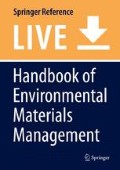Abstract
The goal of this chapter is to have an overview of the publications related to hazardous waste. All publications indexed in the Scopus database with this term in the title, abstract, or keywords are studied, obtaining more than 19,000 records. The subject categories have been analyzed; the most important ones were environmental science, engineering, and medicine. Regarding the trend in the number of publications, four periods have been detected, the last from 2004 to the present with growing interest. In terms of countries, it has been observed that this ranking is led by the United States, followed by China, India, and the United Kingdom. The main institutions with more than 100 publications were the United States Environmental Protection Agency, Chinese Academy of Sciences, Agency for Toxic Substances and Disease Registry, and Oak Ridge National Laboratory. The study of the keywords made it possible to detect 12 clusters, of which only 8 have been considered significant and are the ones that establish the research trends in this field: heavy metals, public health/environmental, incineration, municipal solid waste/landfill, electronic waste, bioremediation, biosafety, and hospital waste.
References
Askarian M, Heidarpoor P, Assadian O (2010) A total quality management approach to healthcare waste management in Namazi Hospital, Iran. Waste Manag 30(11):2321–2326
Atlas RM (2002) Bioterrorism: from threat to reality. Annu Rev Microbiol 56(1):167–185
Bizily SP, Rugh CL, Meagher RB (2000) Phytodetoxification of hazardous organomercurials by genetically engineered plants. Nat Biotechnol 18(2):213
Carvan MJ III, Sonntag DM, Cmar CB, Cook RS, Curran MA, Miller GL (2001) Oxidative stress in zebrafish cells: potential utility of transgenic zebrafish as a deployable sentinel for site hazard ranking. Sci Total Environ 274(1–3):183–196
Cobo M, Gálvez A, Conesa JA, de Correa CM (2009) Characterization of fly ash from a hazardous waste incinerator in Medellin, Colombia. J Hazard Mater 168(2–3):1223–1232
Cole M, Lindeque P, Halsband C, Galloway TS (2011) Microplastics as contaminants in the marine environment: a review. Mar Pollut Bull 62(12):2588–2597
Da Silva CE, Hoppe AE, Ravanello MM, Mello N (2005) Medical wastes management in the south of Brazil. Waste Manag 25(6):600–605
Donkin L (2017) ‘Mons manufactus’: Rome’s man-made mountains between history and natural history (c. 1100–1700). Pap Br Sch Rome 85:171–204
Duan H, Huang Q, Wang Q, Zhou B, Li J (2008) Hazardous waste generation and management in China: a review. J Hazard Mater 158(2–3):221–227
Farzadkia M, Moradi A, Mohammadi MS, Jorfi S (2009) Hospital waste management status in Iran: a case study in the teaching hospitals of Iran University of Medical Sciences. Waste Manag Res 27(4):384–389
Fu J, Zhou Q, Liu J, Liu W, Wang T, Zhang Q, Jiang G (2008) High levels of heavy metals in rice (Oryza sativa L.) from a typical E-waste recycling area in southeast China and its potential risk to human health. Chemosphere 71(7):1269–1275
Griffith J, Duncan RC, Riggan WB, Pellom AC (1989) Cancer mortality in US counties with hazardous waste sites and ground water pollution. Arch Environ Health 44(2):69–74
Isaac GE, Kerr WA (2007) The biosafety protocol and the WTO: concert or conflict? In: The international politics of genetically modified food. Palgrave Macmillan, London, pp 195–212
Jang YC, Lee C, Yoon OS, Kim H (2006) Medical waste management in Korea. J Environ Manag 80(2):107–115
Karademir A, Bakoglu M, Taspinar F, Ayberk S (2004) Removal of PCDD/Fs from flue gas by a fixed-bed activated carbon filter in a hazardous waste incinerator. Environ Sci Technol 38(4):1201–1207
Mondal MK, Balsora HK, Varshney P (2012) Progress and trends in CO2 capture/separation technologies: a review. Energy 46(1):431–441
Mongeon P, Paul-Hus A (2016) The journal coverage of Web of Science and Scopus: a comparative analysis. Scientometrics 106(1):213–228
Montoya FG, Alcayde A, Baños R, Manzano-Agugliaro F (2018) A fast method for identifying worldwide scientific collaborations using the Scopus database. Telematics Inform 35(1): 168–185
Nnorom IC, Osibanjo O (2008) Electronic waste (e-waste): material flows and management practices in Nigeria. Waste Manag 28(8):1472–1479
Padilla FM, Gallardo M, Manzano-Agugliaro F (2018) Global trends in nitrate leaching research in the 1960–2017 period. Sci Total Environ 643:400–413
Park CK (2000) Hydration and solidification of hazardous wastes containing heavy metals using modified cementitious materials. Cem Concr Res 30(3):429–435
Price DJS (1963) Little science, big science. Columbia University Press, New York
Pulido L (2016) Environmental racism. In: International encyclopedia of geography: people, the earth, environment and technology. Wiley Online Library, Hoboken, New Jersey, pp 1–13
Raubenheimer K, McIlgorm A (2018) Can the Basel and Stockholm Conventions provide a global framework to reduce the impact of marine plastic litter? Mar Policy 96:285–290
Sefouhi L, Kalla M, Bahmed L, Aouragh L (2013) The risk assessment for the healthcare waste in the hospital of Batna city, Algeria. Int J Environ Sci Dev 4(4):442
Stomp AM, Han KH, Wilbert S, Gordon MP (1993) Genetic improvement of tree species for remediation of hazardous wastes. In Vitro Cell Dev Biol Plant 29(4):227–232
Taghipour H, Mosaferi M (2009) Characterization of medical waste from hospitals in Tabriz, Iran. Sci Total Environ 407(5):1527–1535
Vann KN, Musson SE, Townsend TG (2006) Factors affecting TCLP lead leachability from computer CPUs. Waste Manag 26(3):293–298
Vrijheid M (2000) Health effects of residence near hazardous waste landfill sites: a review of epidemiologic literature. Environ Health Perspect 108(Suppl 1):101–112
Yoon J, Cao X, Zhou Q, Ma LQ (2006) Accumulation of Pb, Cu, and Zn in native plants growing on a contaminated Florida site. Sci Total Environ 368(2–3):456–464
Author information
Authors and Affiliations
Corresponding author
Editor information
Editors and Affiliations
Section Editor information
Rights and permissions
Copyright information
© 2020 Springer Nature Switzerland AG
About this entry
Cite this entry
Salmerón-Manzano, E., Alcayde, A., Manzano-Agugliaro, F. (2020). Worldwide Research Trends on Hazardous Waste. In: Hussain, C. (eds) Handbook of Environmental Materials Management. Springer, Cham. https://doi.org/10.1007/978-3-319-58538-3_183-1
Download citation
DOI: https://doi.org/10.1007/978-3-319-58538-3_183-1
Received:
Accepted:
Published:
Publisher Name: Springer, Cham
Print ISBN: 978-3-319-58538-3
Online ISBN: 978-3-319-58538-3
eBook Packages: Springer Reference Chemistry and Mat. ScienceReference Module Physical and Materials ScienceReference Module Chemistry, Materials and Physics

